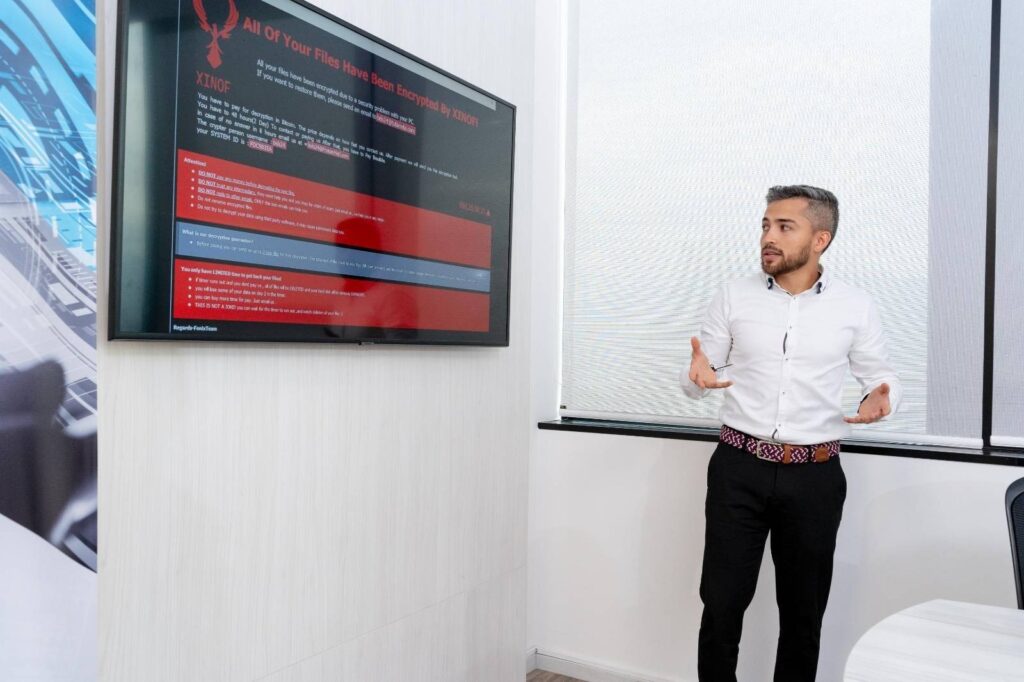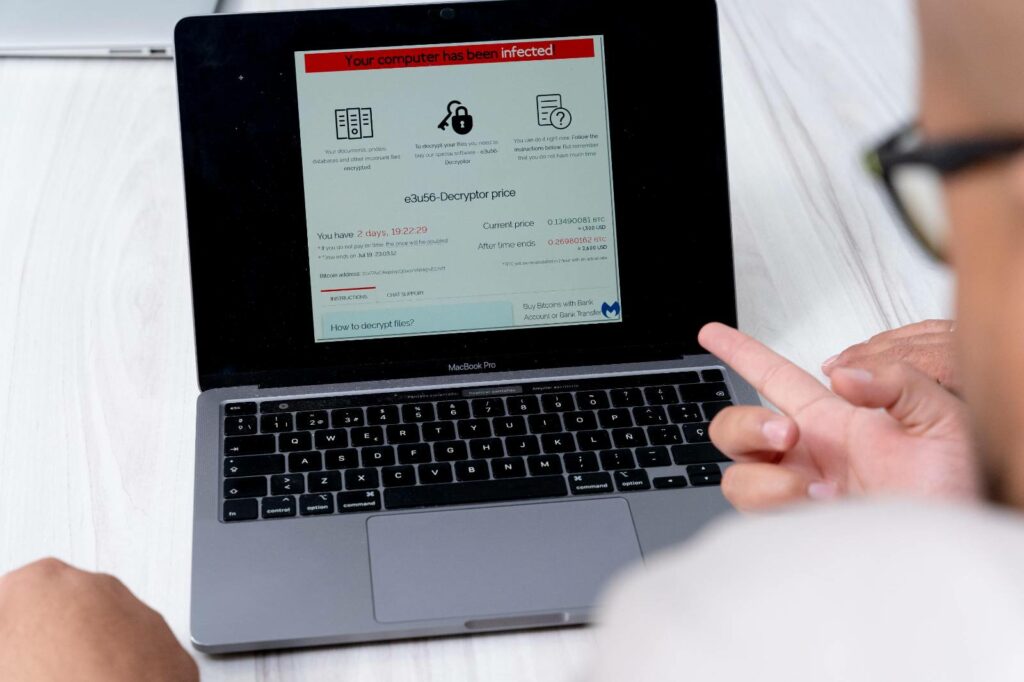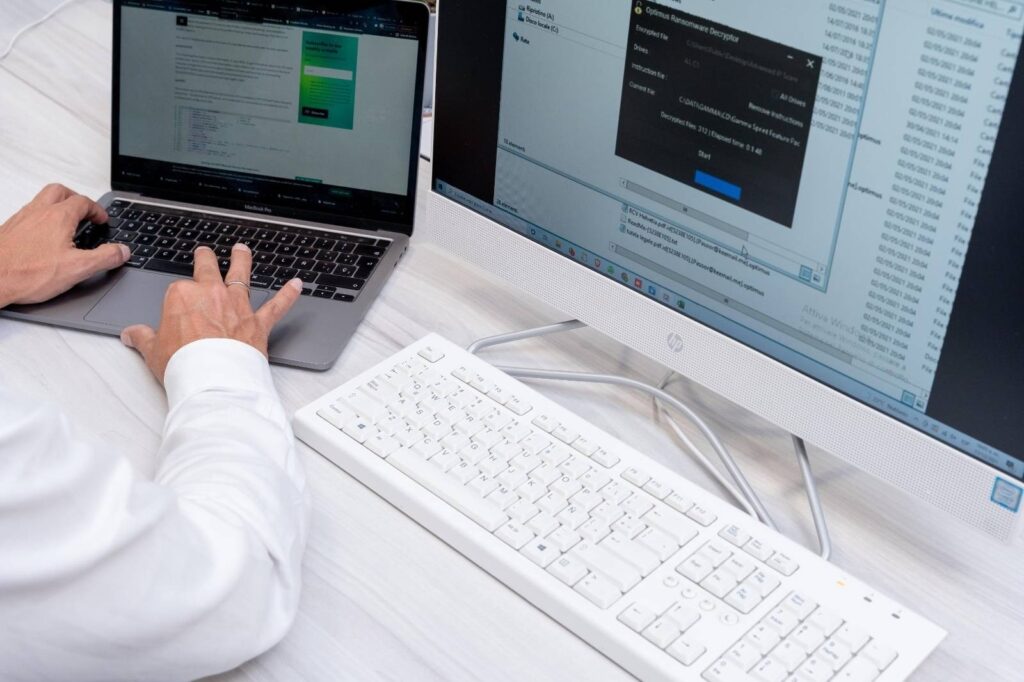Ransomware also on Mac and Linux devices: discover the best security and prevention measures to avoid attacks.
Immediate Ransomware Help
Don’t let ransomware hold your business hostage. Our experts are ready to recover your data and secure your systems.
What is ransomware?
Ransomware is a type of malware that encrypts user data, making it inaccessible.
Once the data is encrypted, the attackers demand a ransom, usually in cryptocurrency, to provide the decryption key and allow the user to recover their data.
This form of attack has gained notoriety in recent years due to its effectiveness and the economic damage it can cause.
As reported by Moonlock, 28% of users believe that this malware does not exist on MacOS devices.

Below we will see why this idea is completely unfounded.
How does ransomware affect Mac and Linux devices?
Many may think that only Windows devices are susceptible to a ransomware attack, but this is a misconception.
As Mac and Linux have grown in popularity and adoption, these operating systems have become increasingly attractive targets for cybercriminals.
Heimdal Security reports that the Linux computing market will reach $22 billion by 2029.

Attackers have developed ransomware variants specifically designed to exploit vulnerabilities in these operating systems.
On the Mac, for example, we’ve seen the emergence of ransomware like KeRanger and Patcher, which attempt to encrypt user data and demand a ransom.
Linux, which is widely used for servers and critical infrastructure, is a particularly attractive target for cybercrimes looking to extract large ransoms.
Variants such as KillDisk and Crypko are examples of ransomware specifically targeting Linux environments.
In addition, the increasing integration of cloud applications and services has broadened the attack surface.
Many Mac and Linux users use cloud services to store and share data.
If a device is compromised by ransomware, data stored in the cloud could also be affected, increasing the impact of the attack.
Ransomware spreading also to Mac and Linux devices
While Windows devices have historically been the primary targets for ransomware, the growing popularity of Mac and Linux has made these systems attractive targets as well.
In recent years, we have seen a significant increase in ransomware attacks also targeting Mac and Linux devices.
According to a report from Trend Micro, the first half of 2022 will see a 75% increase in ransomware attacks targeting Linux services.

This is partly due to the misconception that these systems are immune to malware, making users less cautious and more vulnerable.
How does ransomware affect security and privacy on Mac and Linux?
In addition to data encryption, some ransomware can steal sensitive information and compromise user privacy.
On Mac and Linux, this can include emails, documents, photos, and other personal information.
In addition, the presence of ransomware can indicate other security vulnerabilities in the system that could be exploited by attackers.
As we read in a specific Trend Micro report analyzing infections on Linux:
“What most people don’t know is that Linux runs about 80% of web servers and is the most common operating system for proprietary, embedded, and IoT devices used in industries such as energy and manufacturing.
Linux also powers most U.S. government and military networks, financial and banking systems, and runs the backbone of the Internet.
In addition, Linux runs the database, file and email servers of most organizations. Linux unifies the IT stack and simplifies network management.
Therefore, when an attacker gains access to a Linux environment, he or she gains access to the organization’s most critical systems and data.”

For this very reason, hackers are constantly developing new ransomware and spyware code to infiltrate these systems.
The success of one attack guarantees the possibility of triggering a series of large-scale chain attacks.
HelpRansomware has a team of experts who will follow your case from start to finish with great attention to ransomware data recovery and protecting corporate reputation.

Immediate Ransomware Help
Don’t let ransomware hold your business hostage. Our experts are ready to recover your data and secure your systems.
Security Measures to Protect Mac and Linux Devices from Ransomware
Securing Mac and Linux devices requires a layered approach.
This includes regularly updating software, using antivirus and anti-ransomware solutions, configuring firewalls and network filters, and performing regular backups.
Keep the operating system and applications on Mac and Linux devices up to date
Operating system and application updates often include fixes for known security vulnerabilities.
Keeping your software updated is essential to protect yourself from ransomware.
Moonlock’s analysis shows that only 30% of Mac users regularly update their systems.

The remaining percentage say they are not familiar with updates or skip them.
Use trusted antivirus and antimalware solutions for Mac and Linux
Although Mac and Linux are considered more secure than Windows, they are not immune to malware.
Using antivirus and antimalware or ransomware solutions can help detect and remove threats before they can cause damage.
Configuring firewalls and network filters on Mac and Linux devices
A well-configured firewall can help prevent unauthorized access to your device.
Network filters can block suspicious traffic and reduce the risk of infection.
Contact experts like HelpRansomware to protect your business and personal devices with one-on-one consultations.

Expert Ransomware Removal
Our certified professionals have over 25 years of experience in ransomware removal, data recovery, and computer security.
Make regular backups and keep them in a safe place
Backups are essential for recovering data in the event of a ransomware attack.
It’s important to keep backups in a safe place, separate from your primary device.
Also, according to Moonlock, 54% of Mac users pay for effective archiving services.

Best practices for preventing and detecting ransomware attacks on Mac and Linux devices
The increasing sophistication of ransomware attacks has made it imperative for Mac and Linux users to take solid preventative measures.
As reported by Atlas VPN, the number of new Linux malware samples reached record levels in the first half of 2022, with nearly 1.7 million samples detected.

This represents an increase of nearly +650%.
While Mac and Linux certainly offer robust layers of security, to remove ransomware it requires a proactive, multi-layered approach to security.
Only through a combination of technology, education and awareness can we ensure that these devices remain protected from emerging threats.
Understanding the risks associated with ransomware and adopting best practices can significantly reduce the risk of infection from cyberattacks.
This includes not opening suspicious emails, using only legitimate software, and properly configuring permissions and privileges.
Educate users about the risks of ransomware, including on Mac and Linux devices
User training and education is key to ransomware protection.
As the Moonlock report highlights, over 80% of Mac users are aware of cyber threats and over 50% are concerned about them.

Many attacks succeed because of human error, such as clicking on suspicious links or downloading infected attachments.
Mac and Linux users should be aware that they are not immune and should be educated on security best practices.
Workshops, seminars, and training materials can help raise awareness of threats and how to recognize them.
Avoid opening suspicious emails or downloading attachments
One of the most common tactics used by cybercriminals is to send phishing emails.
These emails may appear to be legitimate communications, but may contain malicious links or attachments.
It is important to always be vigilant and check the source of any email, especially if it contains urgent requests or financial information: it could be a scam.
In fact, as stated in the specific Trend Micro report, scams are the most common type of threat against Linux systems, accounting for 39.3% of cases.

Phishing is the second cause (17.1%), followed by accomplice malware sites (15.4%), infection vectors (13.4%) and C&C servers (9.2%).
Use legitimate software and avoid downloading applications from untrusted sources
Both Mac and Linux have official stores from which to download applications.
However, Moonlock‘s survey shows that 52% of Mac users would like to talk to someone qualified about how to stay safe online.
30% say it is difficult to find a reliable source of information about this.

Downloading software from unofficial sources or unknown websites increases the risk of introducing malware or ransomware to your system.
To recover encrypted files, it is important to stick to official and verified sources or rely on experts.
Configure appropriate permissions and privileges on Mac and Linux devices
Limiting user privileges and making sure they only have the access they need can prevent ransomware from spreading.
If malware or any type of ransomware were to infect an account with limited privileges, its potential damage would also be limited.
Using principles like “least privilege” can make a big difference in the overall security of your system.
Similarly, using different passwords for each account is a security measure that’s within everyone’s reach.
According to the Moonlock report, only 22% of Mac users use the same password for more than one account.

How to deal with a ransomware attack on Mac and Linux devices
Dealing with a ransomware attack on Mac and Linux devices can be a stressful experience.
The key to managing this situation effectively and having a better chance to restore encrypted files is to stay calm and not make hasty decisions.
When an attack is suspected, it is important to avoid panic.
Taking a moment to assess the situation can help you make informed, strategic decisions.
It’s important to remember that every minute counts in ransomware defense, and a quick response can make all the difference in limiting the impact of the attack.
Relying on a team of ransomware prevention and data recovery experts can make all the difference: that’s why HelpRansomware guarantees 24/7 support.

Immediate Ransomware Help
Don’t let ransomware hold your business hostage. Our experts are ready to recover your data and secure your systems.
Another important point is communication: informing stakeholders such as the IT team, business management and users can help coordinate an effective response.
Transparency and openness are essential to ensure everyone is on the same page and to avoid potential reputational damage.
Disconnect the device from the network and report the incident to security experts
If you suspect a ransomware infection, the first thing you should do is disconnect your device from the network.
This will prevent the ransomware from spreading to other devices and will make it easier to decrypt ransomware files after recovery.
Then, it is essential to notify the security team or an outside expert for immediate assessment and intervention.
Do not pay the ransom and seek professional help for data recovery
Paying the ransom does not guarantee the ransomware decryption and may encourage further attacks.
Instead, contact professionals such as HelpRansomware for assistance in managing the incident and attempting data recovery.

Immediate Ransomware Help
Don’t let ransomware hold your business hostage. Our experts are ready to recover your data and secure your systems.
Perform forensic analysis to identify the source and strengthen security
After an attack, understanding how it happened is critical to preventing future incidents.
In addition to discovering the entry vector, forensic analysis is also used to understand what type of ransomware it is.
According to Trend Micro, the top 10 families responsible for attacks on Linux systems in 2022 were:
- Nemucod: 14.7%;
- Blocker: 9.2%;
- Nametrick: 6.8%;
- Locky: 5.6%;
- FRS: 3.3%;
- Petya: 2.8%;
- Cerber: 2.1%;
- Cryptowall: 1.6%;
- WannaCry: 1.6%;
- Cryptesla: 1.4%.

This step is fundamental for all further actions.
A forensic analysis can reveal the ransomware’s entry point and help identify and fix vulnerabilities.
This analysis, performed by experts, will also provide valuable information to strengthen existing security measures.
Conclusions
Ransomware is also a growing threat to Mac and Linux devices.
These are the conclusions you can draw from our guide on the subject:
- 28% of users believe malware doesn’t exist on MacOS devices;
- The Linux computing market will reach $22 billion by 2029;
- The first half of 2022 saw a 75% increase in ransomware attacks targeting Linux services;
- Linux runs about 80% of web servers and is the most common operating system for captive, embedded, and IoT devices used in industries such as energy and manufacturing;
- Only 30% of Mac users regularly update their systems;
- The number of new Linux malware samples reached a record high in the first half of 2022, with nearly 1.7 million samples detected, an increase of nearly +650%;
- 80% of Mac users are aware of cyber threats and over 50% are concerned about them.
Despite the increase in ransomware alerts, even on Mac and Linux devices, taking the right preventative measures that guarantee a reduced response time is essential to protect data and maintain system security.
The key is to be proactive and educate all employees about security threats and best practices.
Remember to always have an ally on your side: HelpRansomware has a team of experts who will follow your case from start to finish with great attention to recovering your data and protecting your company’s reputation.




